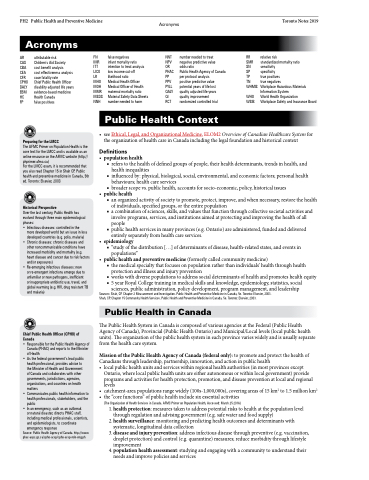Page 1220 - TNFlipTest
P. 1220
PH2 Public Health and Preventive Medicine
Acronyms
Toronto Notes 2019
Acronyms
AR attributable risk
CAS Children’s Aid Society
CBA cost benefit analysis
CEA cost effectiveness analysis CFR case fatality rate
CPHO Chief Public Health Officer DALY disability adjusted life years EBM evidence-based medicine HC Health Canada
FP false positives
Preparing for the LMCC
The AFMC Primer on Population Health is the core text for the LMCC and is available as an online resource on the AFMC website (http:// phprimer.afmc.ca)
For the LMCC exam, it is recommended that you also read Chapter 15 in Shah CP. Public health and preventive medicine in Canada, 5th ed. Toronto: Elsevier, 2003
Historical Perspective
Over the last century, Public Health has evolved through three main epidemiological phases:
• Infectious diseases: controlled in the
more developed world but an issue in less
developed countries (e.g. polio, malaria)
• Chronic diseases: chronic diseases and
other noncommunicable conditions have increased morbidity and mortality (e.g. heart disease and cancer due to risk factors and/or exposures)
• Re-emerging infectious diseases: new
or re-emergent infections emerge due to unfamiliar or new pathogens, inefficient
or inappropriate antibiotic use, travel, and global warming (e.g. HIV, drug resistant TB and malaria)
Chief Public Health Officer (CPHO) of Canada
• Responsible for the Public Health Agency of
Canada (PHAC) and reports to the Minister
of Health
• As the federal government’s lead public
health professional, provides advice to the Minister of Health and Government of Canada and collaborates with other governments, jurisdictions, agencies, organizations, and countries on health matters
• Communicates public health information to health professionals, stakeholders, and the public
• In an emergency, such as an outbreak
or natural disaster, directs PHAC staff, including medical professionals, scientists, and epidemiologists, to coordinate emergency response
Source: Public Health Agency of Canada. http://www. phac-aspc.gc.ca/cpho-acsp/cpho-acsp-role-eng.ph
FN false negatives
IMR infant mortality ratio
ITT intention to treat analysis LICO low income cut-off
LR likelihood ratio
MHO Medical Health Officer MOH Medical Officer of Health MMR maternal mortality ratio MSDS Material Safety Data Sheets NNH number needed to harm
NNT number needed to treat
NPV negative predictive value
OR odds ratio
PHAC Public Health Agency of Canada PP per protocol analysis
PPV positive predictive value PYLL potential years of life lost QALY quality adjusted life years QI quality improvement
RCT randomized controlled trial
RR relative risk
SMR standardized mortality ratio
SN sensitivity
SP specificity
TP true positives
TN true negatives
WHMIS Workplace Hazardous Materials
Information System WHO World Health Organization
WSIB Workplace Safety and Insurance Board
Public Health Context
• seeEthical,Legal,andOrganizationalMedicine,ELOM2OverviewofCanadianHealthcareSystemfor the organization of health care in Canada including the legal foundation and historical context
Definitions
• populationhealth
■ refers to the health of defined groups of people, their health determinants, trends in health, and health inequalities
■ influenced by: physical, biological, social, environmental, and economic factors; personal health behaviours; health care services
■ broader scope vs. public health, accounts for socio-economic, policy, historical issues
• publichealth
■ an organized activity of society to promote, protect, improve, and when necessary, restore the health of individuals, specified groups, or the entire population
■ a combination of sciences, skills, and values that function through collective societal activities and involve programs, services, and institutions aimed at protecting and improving the health of all people
■ public health services in many provinces (e.g. Ontario) are administered, funded and delivered entirely separately from health care services.
• epidemiology
■ “study of the distribution [...] of determinants of disease, health-related states, and events in populations”
• publichealthandpreventivemedicine(formerlycalledcommunitymedicine)
■ the medical specialty that focuses on population rather than individuals’ health through health
protection and illness and injury prevention
■ works with diverse populations to address social determinants of health and promotes health equity ■ 5 year Royal College training in medical skills and knowledge, epidemiology, statistics, social
sciences, public administration, policy development, program management, and leadership
Sources: Shah, CP. Chapter 2 Measurement and Investigation. Public Health and Preventive Medicine in Canada, 5e. Toronto: Elsevier, 2003. Shah, CP. Chapter 15 Community Health Services. Public Health and Preventive Medicine in Canada, 5e. Toronto: Elsevier, 2003.
Public Health in Canada
The Public Health System in Canada is composed of various agencies at the Federal (Public Health Agency of Canada), Provincial (Public Health Ontario) and Municipal/Local levels (local public health units). The organization of the public health system in each province varies widely and is usually separate from the health care system.
Mission of the Public Health Agency of Canada (federal only): to promote and protect the health of Canadians through leadership, partnership, innovation, and action in public health
• localpublichealthunitsandserviceswithinregionalhealthauthorities(inmostprovincesexcept
Ontario, where local public health units are either autonomous or within local government) provide programs and activities for health protection, promotion, and disease prevention at local and regional levels
• catchment-area populations range widely (100s-1,000,000s), covering areas of 15 km2 to 1.5 million km2
• the“corefunctions”ofpublichealthincludesixessentialactivities
(The Organization of Health Services in Canada. AFMC Primer on Population Health, Accessed: March 25 2016)
1. health protection: measures taken to address potential risks to health at the population level through regulation and advising government (e.g. safe water and food supply)
2. health surveillance: monitoring and predicting health outcomes and determinants with systematic, longitudinal data collection
3. disease and injury prevention: address infectious disease through preventive (e.g. vaccination, droplet protection) and control (e.g. quarantine) measures; reduce morbidity through lifestyle improvement
4. population health assessment: studying and engaging with a community to understand their needs and improve policies and services


